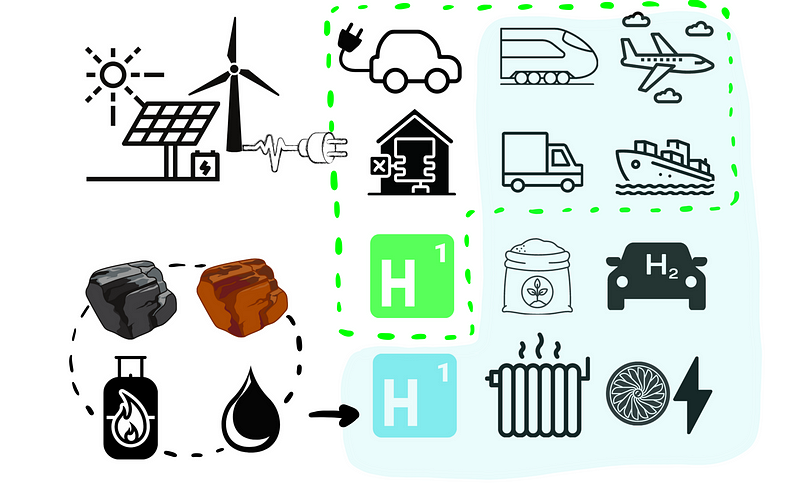Exploring the Role of Blue Hydrogen in Sustainable Energy Plans
Written on
Chapter 1: Understanding Blue Hydrogen
Hydrogen is a hot topic in energy discussions today, and I find myself drawn into this fascination. My initial focus was on green hydrogen — produced through renewable electricity that splits water — but it quickly became clear that green hydrogen isn't the sole type featured in government strategies for "clean" hydrogen. Many countries' hydrogen roadmaps also incorporate blue hydrogen, which is derived from fossil fuels with a significant portion of the CO2 emissions captured. This raises the question: Is blue hydrogen merely a transitional fuel, or does it have a lasting role in our energy future?
Section 1.1: The Appeal of Blue Hydrogen
Initially, I was skeptical of blue hydrogen, primarily because it is heavily promoted by fossil fuel companies, a position I typically oppose. It appeared to me that blue hydrogen was simply a diversion tactic, allowing governments to justify expanding fossil fuel infrastructure under the guise of renewable energy initiatives. They could claim that they would eventually switch to green hydrogen, and if those goals were not met, they could always fall back on hydrogen produced from gas and coal.
Despite these concerns, my research and conversations with hydrogen technology experts have revealed that blue hydrogen may offer certain advantages that green hydrogen cannot, at least not yet.
Subsection 1.1.1: The Unique Benefits of Blue Hydrogen

Blue hydrogen features prominently in the UK’s “Future Energy Scenarios.” Most hydrogen strategies aim for green hydrogen as the end goal, viewing blue hydrogen as a transitional solution. Some governments, like Australia and the UK, include blue hydrogen in their long-term clean energy frameworks.
The rationale behind this inclusion is that green hydrogen technology is not yet commercially viable. While electrolysers capable of producing hydrogen from renewable sources have existed for decades, only a small percentage of global hydrogen production is currently green, primarily due to its higher costs compared to grey or blue hydrogen. For green hydrogen to take a significant role in the energy mix, production capabilities must significantly increase and costs must decrease.
Section 1.2: Challenges Facing Green Hydrogen
Another hurdle for green hydrogen is the limited supply of renewable electricity. Currently, the global electricity grid generates only about 26% to 28% of its energy from renewable sources, with the remainder derived from fossil fuels. As we push towards zero emissions, the demand for electricity will only grow, driven by the transition to electric vehicles, heat pumps for buildings, and other electrification efforts in various industries.

One compelling argument for increasing hydrogen use is its potential to expedite the greening of our economy faster than relying solely on electrification. However, if green hydrogen competes for scarce renewable electricity, this advantage diminishes. Blue hydrogen utilizes significantly less electricity than green hydrogen, providing a viable parallel pathway to decarbonization.
Chapter 2: Evaluating Blue Hydrogen's Viability
So, can blue hydrogen effectively address the challenges faced by green hydrogen? Is its technology advanced enough to bridge the gap until electrolysis technology catches up? And is blue hydrogen the optimal solution to avoid diverting renewable electricity from more efficient applications during this transition?
I have reservations about these assertions. Presently, only seven operational blue hydrogen facilities exist globally (four utilizing gas and three using coal), making it difficult to label this technology as "mature." Furthermore, blue hydrogen production relies on integrating carbon capture and storage (CCS) with fossil fuel hydrogen facilities. However, existing fossil fuel production methods can achieve the same emissions reductions by incorporating CCS without the need for new hydrogen production facilities.
These complex issues warrant more in-depth analysis than I can provide here. I plan to explore them further in a series of articles dedicated to blue hydrogen and carbon capture, usage, and storage (CCUS). Upcoming pieces will involve research and expert interviews to clarify the questions raised in this discussion. Additionally, I will delve into the technologies underpinning blue hydrogen to better understand the processes, efficiencies, CO2 capture rates, and economic implications.
If you have any questions or thoughts about blue hydrogen or carbon capture, feel free to share them in the comments.
The second video title is "Green vs. Blue Hydrogen: Market, Tech, and Cost Realities." This video will provide insights into the differences between green and blue hydrogen technologies, their market positioning, and the economic factors at play.